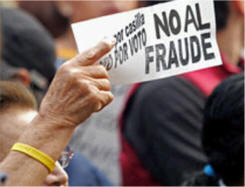 |
 |
 |
 Editorials | At Issue | July 2006 Editorials | At Issue | July 2006  
Previous Rulings May Serve as a Clue
 Union-Tribune Union-Tribune


| | In 1994, Madrazo defeated López Obrador in an election marred by PRI vote-buying. |
On what grounds could the Mexican election results be changed or overturned?

Cases involving the 2004 mayor's race in Mexicali and the 2000 Tabasco governor's race could provide some clues.

The election is now in the hands of Mexico's Federal Electoral Tribunal, or TRIFE. Its decision is due by Sept. 6.

Andrés Manuel López Obrador of the Democratic Revolution Party, or PRD, said this week that he will challenge the results to the TRIFE and ask for a recount.

Official results of Sunday's election gave Felipe Calderón of President Vicente Fox's National Action Party, or PAN, a 243,934-vote victory.

In 2004, the TRIFE upheld a Baja California electoral tribunal ruling to void the results of 74 voting precincts because they only had two workers. Precincts were only supposed to have as few as two workers in extreme cases.

The decision to void the nearly 12,000 votes turned PAN candidate Alejandro Bahena's 118-vote lead into a 111-vote victory for Samuel Ramos of the Institutional Revolutionary Party, or PRI.

In 2000, the TRIFE ruled that a Tabasco state gubernatorial election narrowly won by the PRI was too fraught with errors to be valid. But when the second election took place, the same candidate, Manuel Andrade, won again, defeating the PRD's Raúl Ojeda.

The governor who had helped create the conditions for the Tabasco election to be overturned, Roberto Madrazo, finished third in Sunday's presidential race.

López Obrador may argue that Fox unduly influenced Sunday's election in favor of Calderón through his pronouncements and government public relations spending.

In 1994, Madrazo defeated López Obrador in an election marred by PRI vote-buying. | 
 | |
 |



